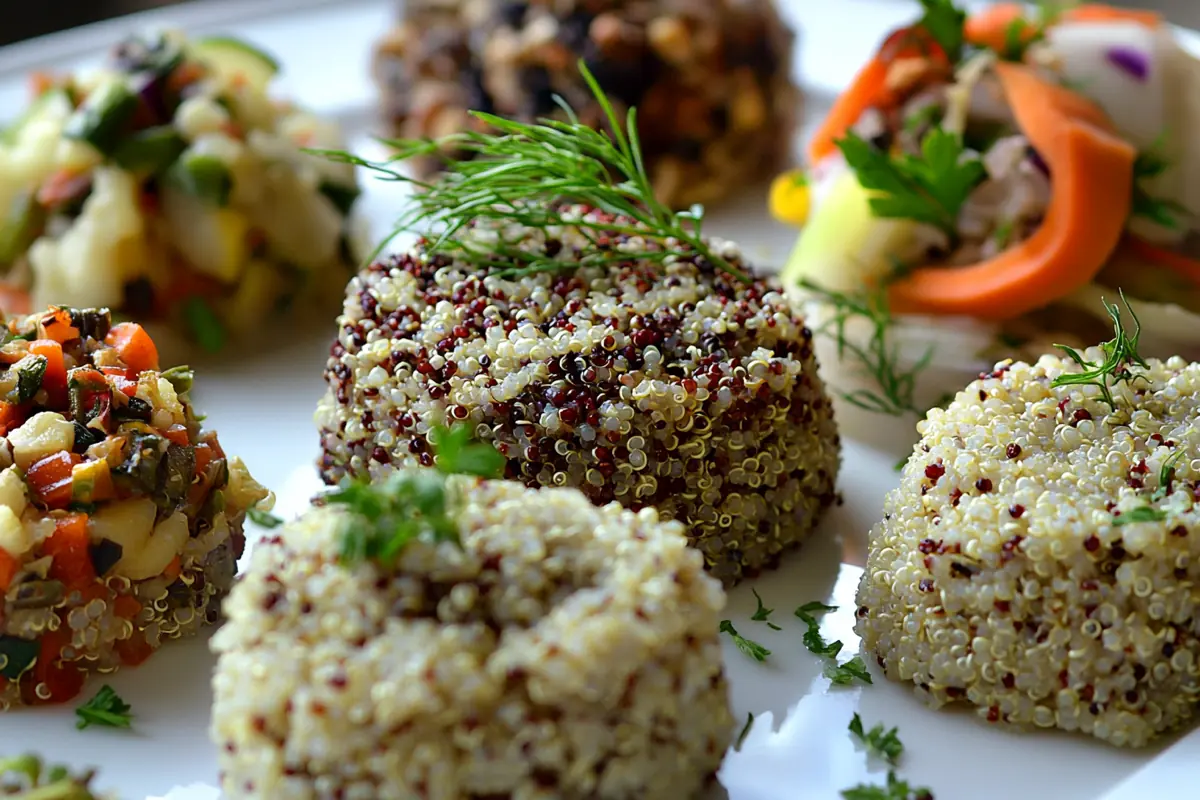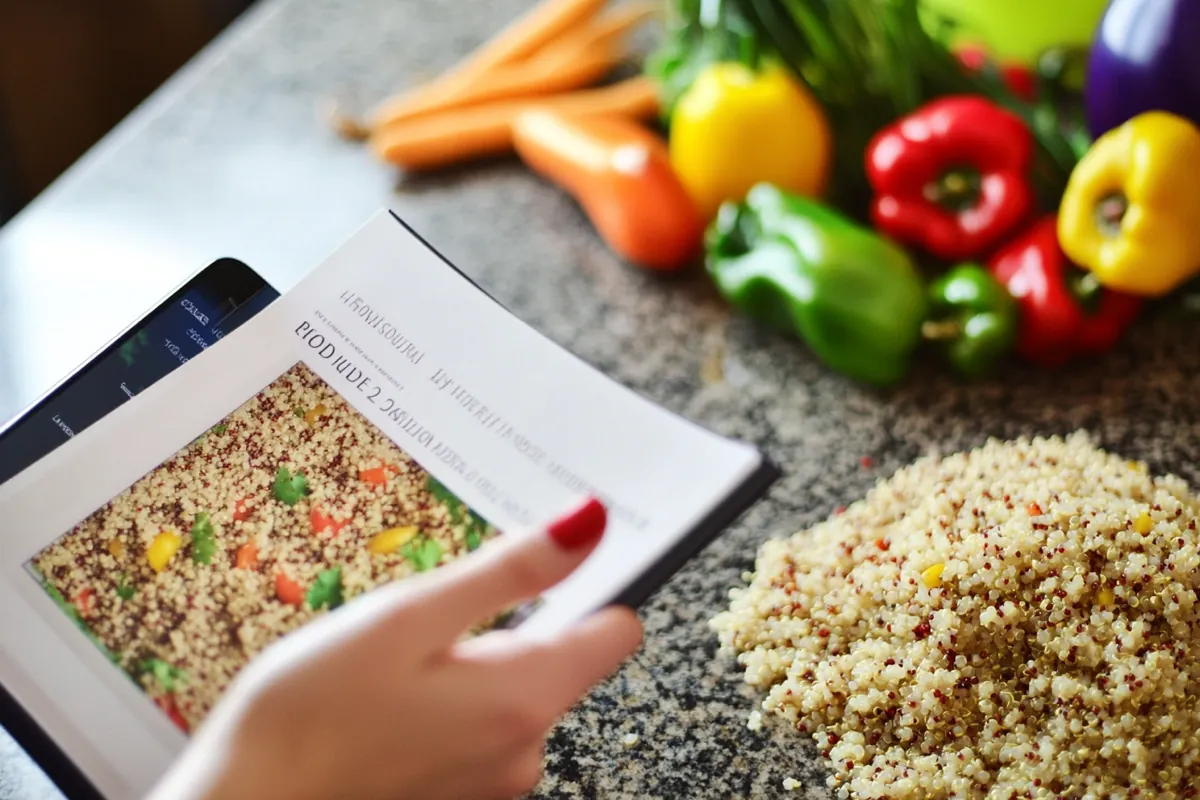Quinoa rice is a remarkable grain that has gained immense popularity in the health and wellness community. Known for its versatility and nutritional benefits, quinoa rice is not only a delicious alternative to traditional grains but also a powerhouse of nutrition. Many people are discovering quinoa rice for its unique taste and exceptional health benefits. This article will delve into what quinoa rice is, its origins, nutritional value, and much more.
Table of Contents
Introduction to Quinoa Rice
Quinoa rice, often simply referred to as quinoa, is a seed that is commonly treated as a grain. It originated in the Andean region of South America and has been cultivated for over 5,000 years. The name “quinoa” comes from the Quechua word “kinwa,” which means “the mother grain.” This ancient superfood has gained a strong reputation in modern diets due to its unique nutritional profile.
What is Quinoa Rice?
Quinoa rice is often marketed as a grain, but it is technically a seed from the plant Chenopodium quinoa. This seed is gluten-free and packed with protein, making it an attractive option for vegans, vegetarians, and those with gluten sensitivities. Quinoa rice comes in various colors, including white, red, and black, each offering slightly different flavors and textures. Because of its nutty taste and fluffy texture, it can be used in salads, soups, and various dishes as a substitute for rice or pasta.
Quinoa Rice Origin
The origin of quinoa rice can be traced back to the Andean civilizations, where it was a staple food for the Inca Empire. The Incas referred to quinoa as “the mother of all grains.” It thrived in harsh climates and was valued not just for its nutritional benefits but also for its adaptability to diverse growing conditions. Today, quinoa rice is grown in various countries, including Peru, Bolivia, and Ecuador, and has become a global staple appreciated for its health benefits.
Quinoa Rice vs. Traditional Rice
When comparing quinoa rice to traditional rice, several key differences emerge. Quinoa rice is higher in protein and fiber than most types of white rice. While white rice is primarily a source of carbohydrates, quinoa rice provides a more balanced profile of nutrients, including essential amino acids, vitamins, and minerals. Additionally, quinoa rice has a lower glycemic index, making it a better choice for those managing blood sugar levels.
Quinoa Rice Nutrition: A Comprehensive Overview
Quinoa rice is not just a delicious food; it is also a nutritional powerhouse. It contains a variety of essential nutrients that can support overall health. Understanding the nutritional content of quinoa rice can help you make informed dietary choices.
Quinoa Rice Calories: How Does It Compare?
One cup of cooked quinoa rice contains approximately 222 calories. This is significantly more than white rice, which has about 205 calories per cup. However, the nutritional benefits of quinoa rice far outweigh the calorie difference. It is packed with protein, making it a filling option for meals. The extra calories in quinoa rice are attributed to its higher content of healthy fats and proteins.
Essential Nutrients in Quinoa Rice
Quinoa rice is rich in various essential nutrients that contribute to its status as a superfood. Here are some of the key nutrients found in quinoa rice:
Protein Content in Quinoa Rice
Quinoa rice is a complete protein source, meaning it contains all nine essential amino acids that our bodies cannot produce. With about 8 grams of protein per cup, it is an excellent choice for those looking to increase their protein intake, especially in plant-based diets.
Fiber Content in Quinoa Rice
One cup of cooked quinoa rice contains about 5 grams of dietary fiber. This is beneficial for digestive health and can help in maintaining a healthy weight. Fiber helps regulate bowel movements and can contribute to feelings of fullness, making it an ideal food for weight management.
Vitamins and Minerals in Quinoa Rice
Quinoa rice is also a good source of various vitamins and minerals. It is rich in magnesium, iron, B vitamins, and zinc. These nutrients play crucial roles in energy production, immune function, and overall health. For instance, magnesium helps in muscle function, while iron is essential for oxygen transport in the blood.

Quinoa Rice Benefits: Why You Should Include It in Your Diet
Incorporating quinoa rice into your diet can yield numerous health benefits. This ancient grain is not only tasty but also offers a range of advantages that can enhance your overall well-being. Understanding these benefits can motivate you to make quinoa rice a staple in your meals.
Health Benefits of Quinoa Rice
Quinoa rice is packed with health benefits that can contribute positively to your diet. Here are some of the most notable advantages of including quinoa rice in your meals:
Weight Management and Quinoa Rice
One of the most compelling reasons to choose quinoa rice is its role in weight management. Because of its high protein and fiber content, quinoa rice can help you feel fuller for longer. This satiety can reduce the likelihood of overeating or snacking between meals. Moreover, quinoa rice’s low glycemic index means it causes a slower rise in blood sugar levels, which can also help control hunger and cravings.
Heart Health and Quinoa Rice
Quinoa rice is heart-friendly, primarily due to its high content of healthy fats and fiber. The fiber helps lower cholesterol levels and supports heart health. Additionally, quinoa is rich in antioxidants, which can combat oxidative stress and inflammation, further promoting cardiovascular health. Including quinoa rice in your diet can be a simple yet effective way to support your heart.
Digestive Health and Quinoa Rice
The fiber content in quinoa rice is also beneficial for digestive health. Fiber aids in regular bowel movements and helps prevent constipation. Furthermore, a diet high in fiber has been linked to a lower risk of developing digestive disorders such as diverticulitis and irritable bowel syndrome. By choosing quinoa rice, you can support a healthy digestive system while enjoying its delicious taste.
Quinoa Rice in Special Diets
Quinoa rice is an excellent choice for various dietary needs, making it a versatile option for many people. Here’s how it fits into specific diets:
Gluten-Free and Quinoa Rice
For individuals with gluten intolerance or celiac disease, quinoa rice is a safe and nutritious alternative to traditional grains. Unlike wheat, barley, and rye, quinoa is naturally gluten-free. This allows those with gluten sensitivities to enjoy a grain-like food without the adverse effects of gluten.
Vegan and Vegetarian Benefits of Quinoa Rice
Quinoa rice is a favorite among vegans and vegetarians due to its high protein content. As a complete protein source, it offers all the amino acids necessary for muscle maintenance and repair. This makes quinoa rice an essential food for individuals following plant-based diets, helping them meet their nutritional needs without relying on animal products.
Low Glycemic Index of Quinoa Rice
Quinoa rice has a low glycemic index, which means it causes a gradual rise in blood sugar levels. This aspect makes it an excellent choice for people with diabetes or those looking to maintain stable energy levels throughout the day. Choosing foods with a low glycemic index can help manage blood sugar and reduce the risk of insulin resistance.
In summary, the quinoa rice benefits extend far beyond its taste. Its nutritional profile supports weight management, heart health, digestive health, and caters to special dietary needs. Adding quinoa rice to your meals can be a delicious way to promote overall health and well-being.

How to Cook Quinoa Rice: A Step-by-Step Guide
Cooking quinoa rice is an easy and rewarding process. Whether you prefer it boiled, steamed, or sautéed, this ancient grain can be enjoyed in numerous dishes. In this section, we’ll explore how to cook quinoa rice, discuss various cooking methods, and share tips to ensure it turns out perfectly every time.
Cooking Quinoa Rice vs. Traditional Rice
When it comes to cooking quinoa rice, the process is slightly different from that of traditional rice. While both grains require water, quinoa typically needs a little extra care. To start, it’s essential to rinse the quinoa thoroughly under cold water. This step removes the natural coating called saponin, which can give quinoa a bitter taste if not washed away.
Once rinsed, the basic cooking method involves a ratio of 2:1 water to quinoa. Bring the water to a boil, add the rinsed quinoa, reduce the heat to low, and cover the pot. Let it simmer for about 15 minutes or until all the water is absorbed. After cooking, let it sit for a few minutes, then fluff it with a fork.
Cooking Methods for Quinoa Rice
There are several methods to prepare quinoa rice, each bringing out different flavors and textures. Here are some popular cooking techniques:
Boiling Method
- Rinse the Quinoa: Place 1 cup of quinoa in a fine mesh strainer and rinse it under cold water.
- Boil Water: In a medium saucepan, bring 2 cups of water to a boil.
- Add Quinoa: Once boiling, add the rinsed quinoa.
- Simmer: Reduce the heat to low, cover the saucepan, and let it simmer for about 15 minutes or until all the water is absorbed.
- Fluff and Serve: Remove from heat, let sit for 5 minutes, then fluff with a fork before serving.
Steaming Method
- Prepare the Steamer: Fill a pot with water and bring it to a boil.
- Rinse the Quinoa: Rinse 1 cup of quinoa thoroughly.
- Steam the Quinoa: Place the rinsed quinoa in a steamer basket or a heatproof dish and set it over the boiling water.
- Cover and Steam: Cover with a lid and steam for about 20 minutes, or until the quinoa is tender and fluffy.
- Serve: Fluff with a fork and enjoy.
Sautéing Method
- Rinse the Quinoa: Rinse 1 cup of quinoa under cold water.
- Sauté in Olive Oil: In a skillet, heat 1 tablespoon of olive oil over medium heat. Add the rinsed quinoa and sauté for 3-4 minutes, stirring frequently.
- Add Water: Pour in 2 cups of water or broth, bring to a boil, then reduce the heat to low.
- Cover and Cook: Cover and simmer for about 15 minutes until water is absorbed.
- Fluff and Serve: Remove from heat, let sit, and fluff before serving.
Tips for Perfectly Cooked Quinoa Rice
To achieve perfectly cooked quinoa rice, consider these helpful tips:
- Use Broth for Flavor: Cooking quinoa in vegetable or chicken broth instead of water enhances its flavor.
- Adjust Liquid as Needed: Depending on the desired texture, you can adjust the water-to-quinoa ratio. For fluffier quinoa, use slightly less water.
- Let It Sit: Allowing quinoa to sit covered for a few minutes after cooking helps improve its texture.
- Experiment with Seasonings: Adding herbs, spices, or garlic during cooking can elevate the flavor of your quinoa rice dishes.
Delicious Quinoa Rice Recipes
Now that you know how to cook quinoa rice, here are two delicious recipes that showcase its versatility:
Quinoa Rice Salad
This refreshing salad is perfect for a light lunch or as a side dish.
- Ingredients:
- 1 cup cooked quinoa rice
- 1 cup cherry tomatoes, halved
- 1 cucumber, diced
- 1/4 cup red onion, finely chopped
- 1/4 cup olive oil
- Juice of 1 lemon
- Salt and pepper to taste
- Instructions:
- In a large bowl, combine the cooked quinoa rice, cherry tomatoes, cucumber, and red onion.
- Drizzle with olive oil and lemon juice, then season with salt and pepper.
- Toss well to combine. Serve chilled or at room temperature.
Quinoa Rice Breakfast Bowl
Start your day with this wholesome and hearty breakfast bowl.
- Ingredients:
- 1 cup cooked quinoa rice
- 1/2 cup fresh spinach, sautéed
- 1/4 cup cherry tomatoes, halved
- 1 fried or poached egg
- 1 tablespoon crumbled feta cheese
- 1 tablespoon olive oil
- Salt and pepper to taste
- Instructions:
- In a bowl, layer the cooked quinoa rice, sautéed spinach, and cherry tomatoes.
- Top with a fried or poached egg.
- Drizzle with olive oil and sprinkle with crumbled feta cheese.
- Season with salt and pepper. Serve warm.

Conclusion: Embracing Quinoa Rice in Your Diet
Quinoa rice is more than just a trendy food item; it is a nutritional powerhouse that offers a multitude of health benefits. From its rich protein content to its essential vitamins and minerals, incorporating quinoa rice into your diet can significantly enhance your overall well-being.
Final Thoughts on Quinoa Rice Benefits
As we’ve explored, the quinoa rice benefits are vast. This versatile ingredient can help with weight management, support heart health, and promote digestive wellness. It fits seamlessly into various diets, making it an ideal choice for anyone looking to eat healthier.
Encouragement to Try Quinoa Rice Recipes
We encourage you to experiment with quinoa rice in your kitchen. Whether you try a simple salad or a hearty stir-fry, the possibilities are endless. By incorporating quinoa rice into your meals, you can enjoy its delicious taste while reaping its numerous health benefits. So, take the plunge and discover how this superfood can transform your dining experience!
FAQ
As quinoa rice continues to gain popularity, many people have questions about its health benefits, preparation, and usage. Here, we address some common inquiries to help you better understand this nutritious grain.
Is Quinoa Rice Healthier?
Yes, quinoa rice is generally considered healthier than traditional rice, especially white rice. It is higher in protein, fiber, and essential nutrients. Additionally, quinoa rice has a lower glycemic index, which means it can help manage blood sugar levels better than standard rice varieties. Including quinoa rice in your diet can lead to improved nutrition and overall health.
What is Quinoa Rice Made Out Of?
Quinoa rice is made from the seeds of the quinoa plant, Chenopodium quinoa. While often referred to as a grain, quinoa is technically a seed. It is harvested, cleaned, and then prepared for consumption. The seeds can be cooked in various ways, making quinoa rice a versatile food option.
Do You Cook Quinoa the Same as Rice?
While the cooking methods for quinoa and traditional rice are somewhat similar, quinoa typically requires rinsing before cooking to remove its natural coating, saponin, which can taste bitter. Additionally, the water-to-quinoa ratio is usually 2:1, while for white rice, it may vary depending on the type. Overall, both grains can be cooked using boiling or steaming techniques, but quinoa requires a few extra steps for optimal flavor.
Is it OK to Replace Rice with Quinoa?
Absolutely! Quinoa can be an excellent substitute for rice in many dishes. It provides a similar texture but with added nutritional benefits, including more protein and fiber. Whether in salads, stir-fries, or as a side dish, quinoa can enhance meals while supporting a healthy diet.




